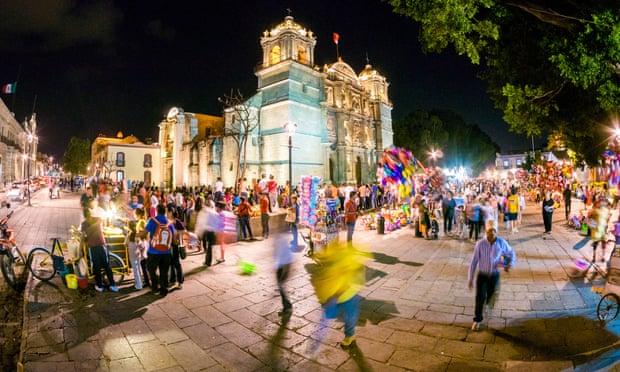| Oaxaca, Mexico – vivid art, joyous festivals – and ant eggs fried in garlic
Oaxaca has some of the richest and strongest traditions in Mexico. If you go in July for the Guelaguetza festival, the whole city explodes. People from ...
|
Oaxaca has some of the richest and strongest traditions in Mexico. If you go in July for the Guelaguetza festival, the whole city explodes. People from the surrounding villages come in their traditional costumes and perform dances at the Cerro del Fortín, a huge amphitheatre on a hill overlooking the city. Guelaguetza means “offering” and refers to the tradition – still alive and strong in rural communities – where if there is an event, everyone contributes, so they have these amazing parties.
Oaxacans are very creative. The area is famous for textiles. The boutique Los Baules de Juana Cata works directly with local artisans and sells beautiful huipiles (embroidered tunics). They can cost up to $1,000 but they take six months to make. There are more crafts on display at the Museo Textil de Oaxaca. I also love the Centro Cultural San Pablo (san-pablo.mx), a beautiful conversion of a 16th-century convent that preserves indigenous traditions. One of Mexico’s most famous artists, Francisco Toledo, is a Oaxacan, who has lent his support to several cultural projects. He designed a stained-glass panel for the San Pablo centre.
Oaxaca’s famed creativity extends to the food scene. The state has the most diverse and the rarest varieties of corn in the entire country and a lot of restaurants focus on traditional recipes. At Itanoní, everything is made from corn. It does amazing tortillas rolled with a whole hoja santa leaf and filled with salsa and bean purée. I love La Teca, too, which is in the chef’s own home. She specialises in local dishes – the mole is delicious.
If you really want to eat like a local you have to try insects. Grasshoppers, agave worms and ants are all popular and sold everywhere, from street stalls to expensive restaurants. Chapulines (grasshoppers) have a very distinctive flavour. I love the small ones in guacamole; and the grasshopper quesadillas at La Popular restaurant are really tasty. Escamoles, or ants’ eggs, are a local speciality too – fried in garlic and butter.
Have a tejate for breakfast and you won’t be hungry for seven hours. It’s the drink of the ancients, made from corn, cacao, cinnamon and mamey fruit and served in a bowl. You’ll find it in any of the markets. The biggest and best-known market in town is 20 de Noviembre. There’s a long row of barbecue stands where you order meat by the kilo and they grill it for you. Then women come along and sell you tortillas or guacamole to go with it.
I live in Mexico City but travel to Oaxaca 12-13 times a year to visit mezcal producers. Unlike in the capital, everything in Oaxaca city is in walking distance. One of my favourite places is the Jardín Etnobotánico. All the plants are from Oaxaca and there are cactus and agave plants saved from development sites. Outside the city, the ancient Zapotec site of Mitla is a very special place that’s not well-known. It’s made up of rectangular buildings, not pyramids, and is famed for its intricate mosaics and stone carvings.
Mezcal is everything tequila is not. Tequila is industrialised. Jose Cuervo can produce up to 3 million litres a month. We sometimes have problems producing 1,500 litres a month because everything is done manually. The agave is still ground by millstones operated by horses. Tequila is made from one type of agave but mezcal uses 23 varieties, so there are many different flavours. Because it’s organic and the fermentation is natural, you can drink more of it without being intoxicated. One of the best places to try it is Los Amantes, the oldest mezcalaría in Oaxaca city. The owner is a famous artist who used to run one of the best clubs in Oaxaca. Spend a few hours there and test the theory that mezcal gets you high, not drunk.
• Santiago is the founder and ceo of artisan mezcal company Mezcal Amores


No comments:
Post a Comment
Thank you. Comments are welcome.
ivan